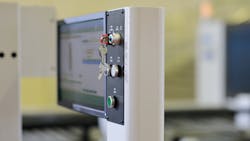Most folks in an automation role with a focus on manufacturing understand what it means to use a system and the controls that run it. What is easily overlooked is the impact the software behind the scenes has on the user interface that we interact with daily.
Software plays a crucial yet less obvious role in the human-machine interface (HMI) in automation systems. It is the hidden but determining element for the way in which the system interacts with the operator, making it an important factor in the overall performance of the system.
There are a number of ways that software affects the HMI in automation systems. Consider the user-interface design. The software used in automation systems determines the design and layout of the HMI. A well-designed user interface makes it easier for the operator to navigate and use the system, which can increase productivity and reduce the number of errors. The difference between a well-organized, well-designed user interface and a poorly laid out or overly complicated design is the difference between functionality and frustration.
The more complicated or confusing a user-interface design is, the less likely the average operator will be successful and efficient in its use. Oftentimes, HMIs get a bad rap because operators fail to grasp the complexities of the system and therefore tend to label the layout as bad.
Anytime a new feature is added to a legacy control there is always resistance from the operators to integrate its benefit into their daily usage. It is not uncommon for it to take a good bit of time and effort before they understand how the new features benefit them.
The greatest features may not be used at all, simply because of the resistance of the operators having to learn or relearn what they believe they already know. It seems like it would be much better to simplify the software behind the HMI, so that there is a greater chance of success for the average operator. A great operator will make an average control better, but a poor control will make even a great operator struggle.
Another aspect of the software that runs the HMI is data collection and analysis. Automation systems use software to collect and analyze data. The HMI is responsible for presenting this information to operators in a clear and concise manner, making it easy for them to monitor the system and make decisions based on the data.
The ability to make improvements at the machine control level is a real advantage of the modern software that runs HMIs, and it is this collection of data that allows this improvement to happen at the grassroots level. It is extremely difficult to affect change and improvement without solid data derived in real time from the automation system itself.
Additionally, the software allows us to monitor alarms and notifications. Software is also responsible for generating alarms and notifications in the HMI. These alerts are critical for informing the operator of any system problems, which helps prevent downtime and increase overall system efficiency. For example, preventive-maintenance warnings on the control can help us stay ahead of scheduled lubrication and coolant demands that the machine or system requires. This allows us to maintain smoother operating automation systems with less downtime, thus increasing uptime for production. Also, the alarms can give us line-of-sight when we are running lights-out operations. When a failure mode happens during an unmonitored run, we can go back and review what happened, when it happened and possibly determine exactly why it happened.
Software grants us the ability to integrate with other systems. Automation systems often use software to integrate with other systems, such as a control system or a manufacturing execution system (MES). The HMI must provide a seamless interface between these systems, making it easier for the operator to access and use the needed data. As our need for systems that have the ability to interact with each other grows, we are seeing that software can help us pull multiple systems together in a cohesive manner.
Overall, the software used in automation systems greatly affects the HMI, making it a critical component of the overall system design and operation. A well-designed HMI can greatly improve the performance and efficiency of the system, while a poorly designed HMI can lead to errors, decreased productivity and increased downtime.
Each system improvement that is made over previous systems and software should work to the end goal of reducing frustration for operators, increasing productivity, simplifying operations and generating higher profitability for investors.
Some of the best controls on the market have been designed in response to extensive market research with end users who have given valuable insights to software developers, who have in turn developed some of the greatest software and HMI enhancements.
About the Author
Andy Watkins
Contributing Editor
Andy Watkins is direct sales manager at Romi Machine Tools in Erlanger, Kentucky. Contact him at [email protected].

Leaders relevant to this article:

